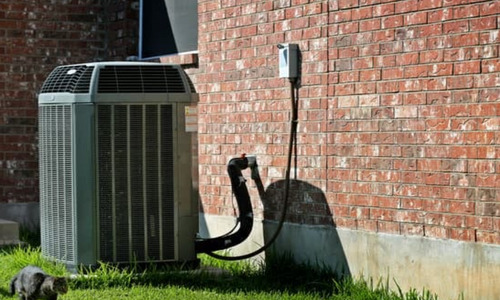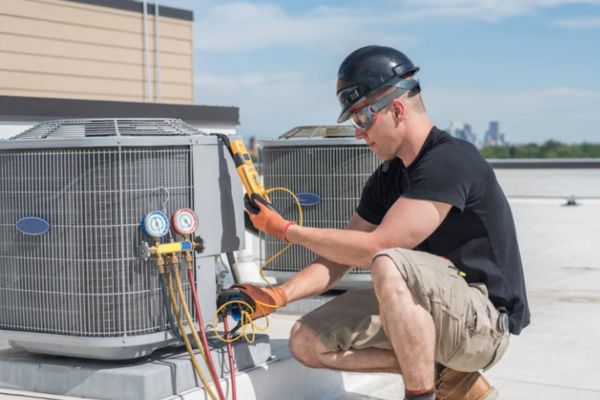Factors That Influence Cost Of AC Unit Installation
Several factors can influence the overall cost of installing a central AC unit. From the size of the unit to the condition of your ductwork, each component plays a role in determining your final bill.

AC Unit Size
One of the most significant factors that impact the cost of a central AC system is the size of the unit. The cooling capacity of central air conditioners is measured in tons, typically ranging from 1.5 to 5 tons for residential properties. The larger the unit, the higher the cost, but choosing the right size for your home is essential to ensure efficient cooling.
- 1.5 to 2 tons: Ideal for smaller homes or apartments – $3,000 – $5,000.
- 3 to 4 tons: Suited for medium-sized homes – $4,000 – $7,500.
- 5 tons: Designed for larger homes or properties with expansive square footage – $6,000 – $10,000.
An appropriately sized unit will cool your home efficiently without wasting energy. An oversized unit might cool quickly but will cycle on and off frequently, which can wear out the system.
Energy Efficiency Ratings (SEER)
The efficiency of a central AC unit is measured by its SEER (Seasonal Energy Efficiency Ratio) rating. Higher SEER ratings indicate more efficient systems that use less energy, but these units come with higher upfront costs.
- Standard SEER Ratings: Range from 13 to 21 – $3,000 – $5,000.
- Energy-Efficient Units: SEER ratings above 16 can save you money on energy bills in the long run but may increase installation costs – $5,000 – $10,000.
While the initial cost is higher for a unit with a higher SEER rating, the energy savings over time make it a wise investment.
Ductwork Requirements
Your home’s ductwork can significantly impact installation costs. If your existing ductwork is in good condition, your overall cost will be lower. However, if repairs or new ducts are required, this can add $1,500 to $5,000 to the total cost, depending on the complexity of the work.
Labor Costs
Labor costs will vary depending on your location and the complexity of the installation. Labor can range from $1,500 to $3,000 for standard installations. Complex installations involving custom ductwork or system upgrades will drive up labor expenses.
Additional Installation Considerations
Beyond the primary factors, additional considerations can increase installation costs. These include zoning systems, electrical upgrades, and required permits.
Zoning Systems
Zoning systems allow you to independently control the temperature in different parts of your home. This is especially useful for larger homes but comes with added costs of $2,000 to $4,000, depending on the number of zones.
Electrical System Upgrades
If your home’s electrical system needs to be upgraded to handle the new AC unit, this could add $1,000 to $3,000 to the total cost. Upgrades may include adding new circuit breakers, wiring, or replacing the electrical panel.
Permits and Inspections
You must obtain permits and pass inspections in most areas when installing a central AC system. Depending on local regulations, these fees typically range from $250 to $1,000.
Choosing the Right Contractor
The quality of your AC installation depends heavily on the contractor you choose. Investing time in finding the right professional is essential to ensure the job is done correctly.
Importance of Multiple Quotes
Getting multiple quotes from certified HVAC contractors is essential to ensure you’re getting a fair price. Installation costs vary widely, and comparing several offers helps avoid overpaying or choosing an inexperienced installer.
Credentials and Insurance
Ensure the contractor you choose is licensed, insured, and experienced in installing central AC systems. This guarantees a smooth installation process and protects you in case of damages or accidents during the installation.
Long-Term Cost Considerations
While the upfront installation cost is a significant concern, long-term savings should also be considered. Energy-efficient units and proper installation can save you money down the road.
Energy Savings from Efficient Units
Higher SEER-rated units cost more initially, but they lead to lower energy bills in the long run. You can recoup some of your installation costs through energy savings over time by choosing an energy-efficient system. Additionally, specific high-efficiency models may qualify for tax credits or rebates.
Proper Sizing and Installation
Choosing the right size and ensuring proper installation is critical for your system’s long-term performance. An undersized unit will struggle to cool your home, while an oversized unit may cool too quickly, leading to frequent cycling and unnecessary wear.
Financing and Rebates
Many homeowners are unaware of the financing and rebate options available for AC installation. These options can make the project more affordable and reduce upfront costs.
Financing Options
Many contractors and HVAC companies offer financing plans to make the installation cost more manageable. This can include monthly payment plans or deferred-interest loans. Be sure to ask your contractor about available financing options.
Rebate Programs
Government agencies and energy companies often provide rebates for installing energy-efficient AC systems. This can help lower your upfront costs. Check for available rebate programs in your area, as they vary by region and utility provider.
Conclusion
Investing in a central air conditioning system is a significant decision that impacts your home’s comfort and energy costs for years. You can make a well-informed choice by understanding the factors that affect installation costs, such as unit size, energy efficiency, and labor. Remember to get multiple quotes from qualified contractors and explore financing and rebate options to make the process smoother. Home Star is your top directory for connecting with trusted HVAC professionals who can guide you through installation, repair, and maintenance for your HVAC needs.



